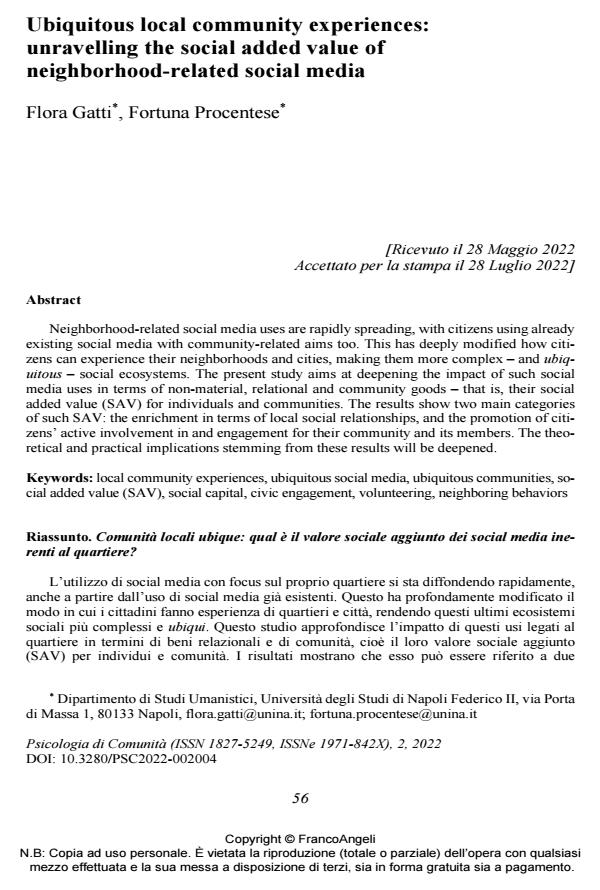Ubiquitous local community experiences: unravelling the social added value of neighborhood-related social media
Titolo Rivista PSICOLOGIA DI COMUNITA’
Autori/Curatori Flora Gatti, Fortuna Procentese
Anno di pubblicazione 2022 Fascicolo 2022/2
Lingua Inglese Numero pagine 24 P. 56-79 Dimensione file 251 KB
DOI 10.3280/PSC2022-002004
Il DOI è il codice a barre della proprietà intellettuale: per saperne di più
clicca qui
Qui sotto puoi vedere in anteprima la prima pagina di questo articolo.
Se questo articolo ti interessa, lo puoi acquistare (e scaricare in formato pdf) seguendo le facili indicazioni per acquistare il download credit. Acquista Download Credits per scaricare questo Articolo in formato PDF

FrancoAngeli è membro della Publishers International Linking Association, Inc (PILA)associazione indipendente e non profit per facilitare (attraverso i servizi tecnologici implementati da CrossRef.org) l’accesso degli studiosi ai contenuti digitali nelle pubblicazioni professionali e scientifiche
Neighborhood-related social media uses are rapidly spreading, with citizens using already existing social media with community-related aims too. This has deeply modified how citizens can experience their neighborhoods and cities, making them more complex - and ubiquitous - social ecosystems. The present study aims at deepening the impact of such social media uses in terms of non-material, relational and community goods - that is, their social added value (SAV) for individuals and communities. The results show two main categories of such SAV: the enrichment in terms of local social relationships, and the promotion of citizens’ active in-volvement in and engagement for their community and its members. The theoretical and practical implications stemming from these results will be deepened.
L’utilizzo di social media con focus sul proprio quartiere si sta diffondendo rapidamente, anche a partire dall’uso di social media già esistenti. Questo ha profondamente modificato il modo in cui i cittadini fanno esperienza di quartieri e città, rendendo questi ultimi ecosistemi sociali più complessi e ubiqui. Questo studio approfondisce l’impatto di questi usi legati al quartiere in termini di beni relazionali e di comunità, cioè il loro valore sociale aggiunto (SAV) per individui e comunità. I risultati mostrano che esso può essere riferito a due principali cate-gorie: l’arricchimento in termini di relazioni sociali locali e la promozione di coinvolgimento e impegno attivo dei cittadini nella e per la loro comunità. Saranno discusse le implicazioni teori-che e pratiche derivanti da questi risultati.
Parole chiave:comunità locali, social media ubiqui, comunità ubique, valore sociale aggiunto, capitale sociale, impegno civico, volontariato, comportamenti di vicinato
- Ubiquitous processes strengthening neighbourhood communities: How neighbourhood‐related social media can foster the active involvement of citizens and build resilient communities Flora Gatti, Fortuna Procentese, in Journal of Community & Applied Social Psychology e2862/2024
DOI: 10.1002/casp.2862 - Community‐based participatory research for urban regeneration: Bridging the dichotomies through the exp‐EIA method Nicola Rainisio, Marco Boffi, Barbara Piga, Gabriele Stancato, Natalia Fumagalli, in Journal of Community & Applied Social Psychology e2877/2024
DOI: 10.1002/casp.2877 - The power of connection: Resource and responsibility in the virtual community experience of Italian trans and gender‐diverse activists Christian Compare, Maric Martin Lorusso, Cinzia Albanesi, in Journal of Community & Applied Social Psychology e2859/2024
DOI: 10.1002/casp.2859 - What can we learn from critical, liberation, and decolonization community psychologists of the global South? Donata Francescato, in RIVISTA DI PSICOLOGIA CLINICA 1/2024 pp.61
DOI: 10.3280/rpc1-2024oa18168 - “Who Cancelled Lee Highway?”: Expressions of White Racial Frames and Counterframes on Nextdoor Shayna Maskell, in Journal of Ethnic and Cultural Studies /2024 pp.1
DOI: 10.29333/ejecs/1617 - Suicide on Italian Instagram: Insights and implications for prevention and support Martina Olcese, Lorenzo Antichi, Francesco Madera, Paola Cardinali, Davide Prestia, Gianluca Serafini, Davide Dettore, Silvia Casale, Marco Giannini, Giovanni Martinotti, Laura Migliorini, in Journal of Community & Applied Social Psychology e2844/2024
DOI: 10.1002/casp.2844
Flora Gatti, Fortuna Procentese, Ubiquitous local community experiences: unravelling the social added value of neighborhood-related social media in "PSICOLOGIA DI COMUNITA’" 2/2022, pp 56-79, DOI: 10.3280/PSC2022-002004